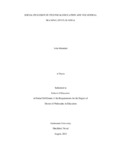
Please use this identifier to cite or link to this item:
https://hdl.handle.net/20.500.14301/231| Title: | SOCIAL INCLUSION IN TECHNICAL EDUCATION AND VOCATIONAL TRAINING (TEVT) IN NEPAL |
| Authors: | Bhandari, Usha |
| Citation: | Bhandari,U.(2012).Social inclusion in technical education and vocational training (TEVT) in Nepal. |
| Issue Date: | Aug-2012 |
| School: | SOED |
| Department: | DOEL |
| Level: | Ph.D. |
| Program: | PhD in Development Education |
| Abstract: | This thesis proceeds with the question that why inequality and injustice prevail in the Technical Education and Vocational Training (TEVT) sector despite the social inclusion efforts at different levels as a national agenda. With the major purpose of analyzing the existing situation of social inclusion in the TEVT and associated challenges and opportunities, this study specifically explore the current policy provisions, practices and gaps between policy and practice as well as the perception of beneficiaries on practices of social inclusion in the TEVT field. The study basically applies qualitative research methods under the interpretive paradigm. It also uses a small portion of quantitative data to analyze the phenomena in detail to reach to the closer reality. The analysis was thus based on textual description of people’s perception, a few numerical data, and the synthesized essence of the social inclusion facts in the TEVT sector. This study ascertains that social inclusion in the TEVT is conceived as a mere political concept rather than an analytic concept. Further, it is perceived as a response to social exclusion and more emphasis is given to the process than the outcome. The social exclusion has been explained as outcome of deprivation based on gender, caste, ethnicity, regional belongingness, and income-poverty. Where as the social inclusion is often taken as a remedy to social exclusion, meaning the mere inclusion of the excluded groups. Such positivistic notion is too generic to account for individual experiences of social exclusion and ignore the contextual and relational factors that increase or decrease the level of exclusion. Further, the policies and practices of social inclusion in the TEVT are found to be emerged with top –down approach, not reflecting the mutual understanding and experiences of socially excluded group, implementers and policy makers, and then limiting the efforts in addressing the social inclusion in day-to-day practices. Similarly, the study has found that in everyday discourse of social inclusion in the TEVT, the terms like, participation, equity, equality, access, sustainability, scholarships, quota are quite frequently used idioms that are associated with social inclusion. However, in reality these terms are not addressed adequately as there are ingrained cultural practices, patriarchal thinking and deeply rooted social taboos as obstacle to social inclusion at institutional level. These factors are further perpetuating exclusion at institutional level, necessitating the social inclusion efforts beyond integration of socially excluded groups, rather focus on social change. In addition, the study point out that social inclusion is identified as vibrant force to bring changes at individual level and in community level. Changes on people’s perception, attitude and the thinking pattern in terms of attainment of the basic level of wellbeing through the participation, equal opportunities, and increased life chances are identified as some of the outcomes of social inclusion in the TEVT. The study concludes that social inclusion in the TEVT is an attractive concept for policy makers. Using this concept without the analytical perspectives and coherent theoretical core has led to limited benefits for the larger society. There is a need of devising context specific strategy; namely, the need of rethinking of social inclusion policy and practices in the TEVT. |
| URI: | https://hdl.handle.net/20.500.14301/231 |
| Appears in Collections: | Theses |
Files in This Item:
| File | Description | Size | Format | |
|---|---|---|---|---|
| thesis_final_draft_usha_September 15.pdf | 2.55 MB | Adobe PDF |  View/Open |
Items in DSpace are protected by copyright, with all rights reserved, unless otherwise indicated.